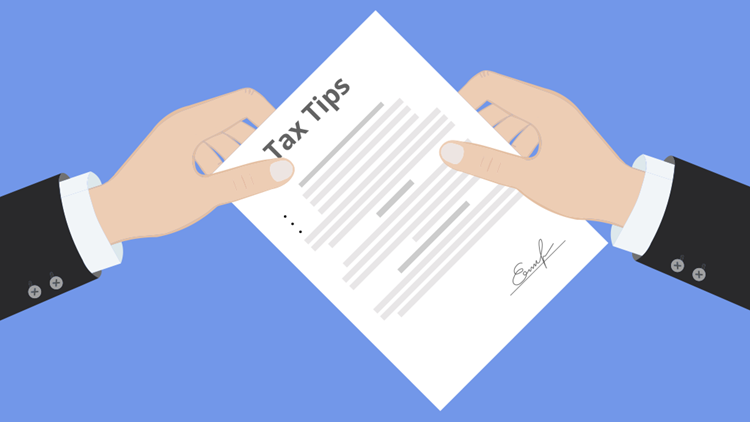by | Feb 8, 2022 | Tax Tips and News
Protecting taxpayer data from scammers and preventing identity theft tax refund fraud has long been a chief concern for the Internal Revenue Service, and pursuing this mission lead the agency to form the Security Summit. While the agency has worked tirelessly alongside state officials and private members of the tax industry to spread awareness of data-security issues and provide guidance on best practices, recently planned efforts to better secure IRS.gov accounts have been abandoned following criticism.

Last week, it was reported that the IRS would begin requiring third-party facial recognition verification to access certain tax information via online accounts this summer. This news caused some members of Congress to raise concerns about taxpayer privacy, ultimately resulting in today’s announcement by the agency that they will be abandoning the program. Despite this setback, the IRS notes that they will look into other methods for securing these accounts that will not affect filing season.
“The transition will occur over the coming weeks in order to prevent larger disruptions to taxpayers during filing season,” the IRS explains. “During the transition, the IRS will quickly develop and bring online an additional authentication process that does not involve facial recognition. The IRS will also continue to work with its cross-government partners to develop authentication methods that protect taxpayer data and ensure broad access to online tools.”
The IRS closes the release by assuring that this process will not affect filing season, encouraging taxpayers to “continue to file their taxes as they normally would.” Once the agency announces their chosen alternative verification method, we will provide an update on Taxing Subjects.
Sources: IR-2022-27; “The IRS plan to require face scans raises concerns about privacy and security,” WBUR.org; “Want information from the IRS? For some, the agency wants a selfie,” NPR.org
– Story provided by TaxingSubjects.com
by | Feb 4, 2022 | Tax Tips and News
The wait is over; the filing season for 2021 income tax returns has been opened by the IRS. But before taxpayers start sharpening pencils, cranking up the calculator and putting on a pot of coffee, they need to know they’ve got everything together to get the job done right.
The IRS has put together its annual Tax Time Guide that helps taxpayers navigate the trials of taxes and file an accurate return. Here are some tips that can make anyone’s income tax season a lot less daunting.

Wait for it…
As much as some taxpayers want to get started on their taxes early in the game, it’s a better bet not to file prematurely. Unless a taxpayer knows they have all the right documents at hand, they risk making mistakes that could delay or even cost them their refund.
January is usually the month when year-end forms start showing up in taxpayers’ mailboxes, or are sent via email. No matter how they arrive, taxpayers need to carefully look over their forms and contact the payer immediately if a correction is needed or an updated mailing or email address.
Some forms—like some Forms 1099, for example—don’t have to be issued until later in the tax filing season.
Here’s a quick list of important forms taxpayers may need to file, but should wait until they have these in hand before they do:
- Forms W-2 from employer(s)
- Forms 1099 from banks, issuing agencies and other payers including unemployment compensation, dividends and distributions from a pension, annuity or retirement plan
- Form 1099-K, 1099-MISC, W-2, or other income statement if they worked in the gig economy
- Form 1099-INT if they received interest payments
- Other income documents and records reporting virtual or crypto currency transactions
- Form 1095-A, Health Insurance Marketplace Statement, to reconcile advance Premium Tax Credits for Marketplace coverage
- Letter 6419, 2021 Total advance Child Tax Credit Payments to reconcile advance Child Tax Credit payments
- Letter 6475, 2021 Economic Impact Payment, to determine eligibility to claim the Recovery Rebate Credit
Report advance payments
This year, there’s a new wrinkle in the form of Letter 6419, Advance Child Tax Credit Reconciliation, which was sent out in January by the IRS. Taxpayers need to use the letter to compare the amount of the Child Tax Credit they received in advance payments in 2021 with the total amount of the credit they should get. If there’s any remaining credit they can claim, they can receive it in the form of a tax refund.
If they were paid more in advance than they qualify for, however, those taxpayers may have to pay extra tax due to make up the difference.
As with all pertinent tax documents, the IRS urges taxpayers to check this information carefully.
Taxpayers who were issued a third Economic Impact Payment won’t have to include anything about it on their income tax return. Those who didn’t qualify for a third payment—or didn’t get the full amount—may be eligible for some of it in the form of the 2021 Recovery Rebate Credit.
To claim the credit, taxpayers need the total amount of their third Economic Impact Payment for inclusion on their return. Taxpayers can get the amount from their Online Account on IRS.gov, or they can wait to receive Letter 6475 in the mail.
The Online Account can be a very powerful tool for filers, providing their tax information securely and quickly.
Using the Online Account when filing returns, taxpayers can see:
- The total amounts of Economic Impact Payments issued for tax year 2021
- The total amount of advance Child Tax Credit payments
- Their adjusted gross income from their last tax return
- The total of any estimated tax payments they made, and refunds applied as a credit
Taxpayers can do more than that, of course. After logging in, taxpayers can make and track their tax payments and manage their communication preferences. They’ll also have the option to go paperless and request email notification for certain notices available online.
Taxpayers who would like to get their IRS tax notices in Braille, large print, audio or electronic formats can download Form 9000, Alternative Media Preference from the IRS website.
Once completed, the form can be mailed in by itself, included along with the taxpayer’s tax return, or taxpayers can call the IRS at 800-829-1040 to choose their preferred format.
Similarly, Spanish speakers—or those who speak one of 20 other languages—can use Schedule LEP, Request for Change in Language Preferences, to get communications in their particular language. Forms 1040 and 1040-SR are now available in Spanish.
e-File and direct deposit are encouraged
Lastly, the IRS strongly encourages taxpayers to file their income tax returns by electronic means, avoiding paper returns, and to choose direct deposit for any refunds. That, they stress, will speed up processing and keep refunds moving quickly – 21 days in most cases.
In addition, taxpayers should take extra steps to ensure they’re filing an accurate return. Mistakes in copying figures, math errors and other lapses can lead to a return being reviewed by an IRS employee, and that takes time. Paper, whether in the form of a paper return or a paper check will take even longer to process this tax season.
Need additional help? See Publication 17, Your Federal Income Tax (For Individuals) on IRS.gov.
Source: IR-2022-23
– Story provided by TaxingSubjects.com
by | Feb 4, 2022 | Tax Tips and News
The Internal Revenue Service is pushing out a new version of its frequently asked questions (FAQs) for the 2020 Recovery Rebate Credit. The updated information is featured in Fact Sheet 2022-08, which carries the latest information pertaining to tracing payments.

While most of the information on the Fact Sheet was updated in December 2021, Question 8 under Topic F: Finding the First and Second Economic Impact Payment Amounts to Calculate the 2020 Recovery Rebate Credit is hot off the presses, being updated February 2 of this year:
QF8. Missing Economic Impact Payment: How do I request a payment trace to track my first and second Economic Impact Payments?
A8. You should only request a payment trace to track your payment if your online account shows a first or second payment was issued to you and you have not received it. Do not request a payment trace to determine if you were eligible for a payment or to confirm the amount of payment you should have received.
How the IRS processes a claim
We’ll process your claim for a missing payment in one of two ways:
- If a trace is initiated and the IRS determines that the check wasn’t cashed, the IRS will credit your account for that payment, but the IRS cannot reissue your payment. Instead, you will need to claim the 2020 RecoveryRebate Credit on your 2020 tax return if eligible.
- Note: If you are filing your 2020 tax return before your trace is complete, do not include the payment amount on line 16 or 19 of the Recovery Rebate Credit Worksheet. If you do, you may receive a notice saying your 2020 Recovery Rebate Credit was changed, but an adjustment will be made after the trace is complete and it is determined your payment has not been cashed. You will not need to take any additional action to receive the credit. If you do not request a trace on your payment, you may receive an error when claiming the 2020 Recovery Rebate Credit on your 2020 tax return. Since the payment was issued to you, you may not be eligible for any credit.
- If the check was cashed, the Treasury Department’s Bureau of the Fiscal Service will send you a claim package that includes a copy of the cashed check. Follow the instructions. The Treasury Department’s Bureau of the Fiscal Service will review your claim and the signature on the canceled check before determining whether the payment can be reversed and your Recovery Rebate Credit adjusted.
The Fact Sheet goes on to explain that taxpayers initiating a trace need to complete Form 3911, Taxpayer Statement Regarding Refund, and gives instructions on transmitting the form to the IRS.
Alternatively, they can also call the IRS at 800-919-9535 to start a trace.
Encouraging non-filers to file
Many of the FAQs updated in December concentrate on answering the questions of non-filers who fear they might miss out on the Recovery Rebate Credit.
For example, one question asks if a taxpayer didn’t qualify for a Economic Impact Payment, would they still qualify for the Recovery Rebate Credit?
They IRS’ answers with a maybe. There are changes, the IRS stresses, that could change a taxpayer’s eligibility to the good for the credit. The first and second Economic Impact Payments were based on the taxpayer’s 2018 and 2019 income tax returns. If circumstances changed in 2020, that means eligibility for the Recovery Rebate Credit could’ve changed as well.
Here are some life changes that could open the door to qualifying for the Recovery Rebate Credit for 2020:
- Income change: Your adjusted gross income went down in 2020.
- Qualifying child: You welcomed an eligible child in 2020 who was under the age of 17 at the end of 2020.
- No longer a dependent: You were no longer eligible to be claimed as a dependent on someone else’s tax return in 2020.
- Social Security number: You received a Social Security number valid for employment before the due date of your 2020 return (including extensions).
The IRS reminds that FAQs should not be relied on for official tax law in formal proceedings such as those before the Tax Court, but are meant only to transmit changes to taxpayers quickly. More information on such reliance is available from the IRS.
Visit the IRS website, IRS.gov, for more information on the Recovery Rebate Credit.
Sources: IRS provides revised answer for 2020 Recovery Rebate Credit on tracing payments; Fact Sheet 2022-08
– Story provided by TaxingSubjects.com
by | Feb 1, 2022 | Tax Tips and News
The Internal Revenue Service has posted a new flock of frequently asked questions (FAQs), all aimed at answering taxpayer questions about the 2021 Child Tax Credit.
The new FAQs are published in Fact Sheet 2022-06.
The Child Tax Credit, expanded only for the 2021 tax year, is likely to be one of the big topics of interest to many filers this tax season.

Those taxpayers who got advance payments of the Child Tax Credit have to compare the total they got in advance payments during the tax year with the amount of the credit they can claim on their 2021 tax return.
Ideally, their advance payments could be as much as half of the total credit; they have to file to receive the remainder of the Child Tax Credit as a refund. However, if a taxpayer received more than what they qualify for, they may need to repay some—or all—of the excess paid out.
Expect a letter soon if you received the Advance Child Tax Credit
Letter 6419 has been sent out by the IRS to those who received advance Child Tax Credit payments. It provides these taxpayers with the total amount of advance payments they received during the 2021 tax year. Taxpayers who get this letter are being urged by the IRS to hang onto the document as part of their important tax documents, since they may need it to prepare their returns this season.
The new FAQs help to explain the workings of the Child Tax Credit in a number of scenarios:
Fact Sheet 2022-06 makes it clear, however, that these new FAQs are for the benefit of taxpayers and shouldn’t take the place of the rule of law in deciding tax cases.
“Accordingly, these FAQs may not address any particular taxpayer’s specific facts and circumstances, and they may be updated or modified upon further review,” the Fact Sheet explains.
“Because these FAQs have not been published in the Internal Revenue Bulletin, they will not be relied on or used by the IRS to resolve a case. Similarly, if an FAQ turns out to be an inaccurate statement of the law as applied to a particular taxpayer’s case, the law will control the taxpayer’s tax liability.”
The IRS stresses that FAQs are simply the vehicle the agency uses to get information to taxpayers quickly.
Sources: IR-2022-21; Fact Sheet 2022-06
– Story provided by TaxingSubjects.com








